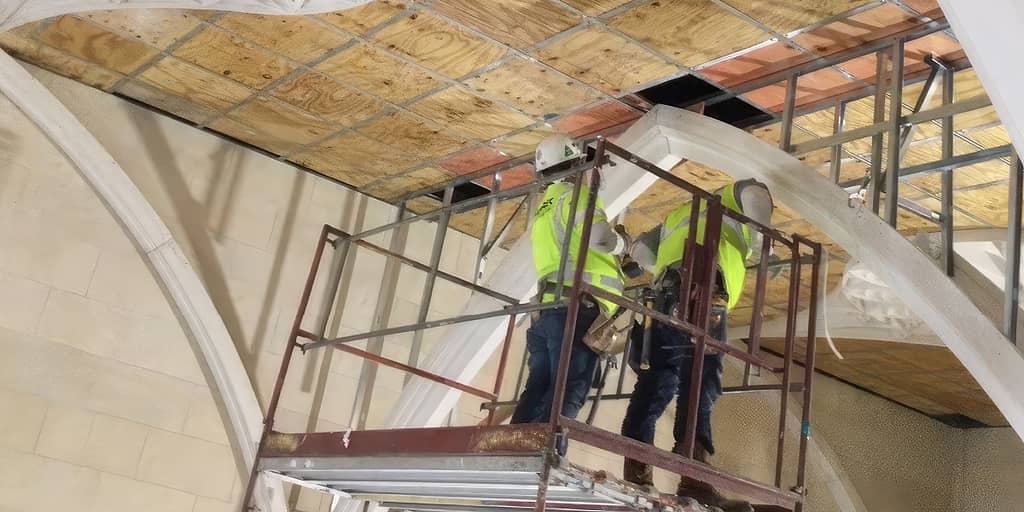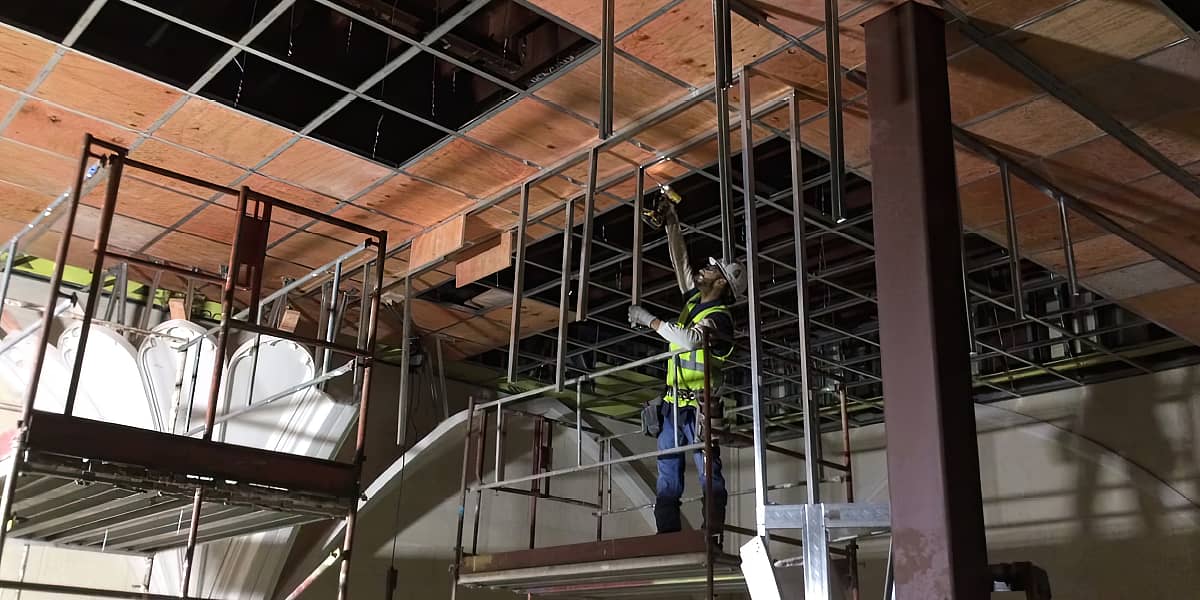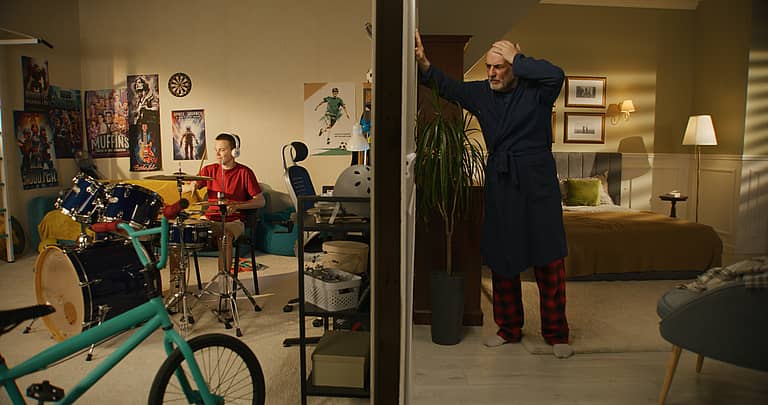Marek is one of the country’s large wall and ceiling contractors, but it didn’t get there overnight. The company was founded in Houston in 1938 and has grown to have eight branches today, a number of which have their signature on landmark projects in their region. At its Dallas branch, for example, Marek’s name is on the Dallas Cowboys/AT&T Stadium, American Airlines Center, DFW Airport, Rangers Stadium, Granite Park Hilton Hotel, Bluestar Omni Hotel and Trinity Regional Hospital.
Specialty and custom ceilings are often part of its business. Among recent notable ceiling contracts is at the Lanier Theological Library Conference Center completed early in 2023 in Houston. The design of the 1,600-square-foot ceiling was based on a space that was supposed to be perfectly square with a center column equally splitting the area into four quadrants. Field measurements for shop drawings by Marek, however, indicated the space was out of square and the center column was off center.
“[The ceiling manufacturer] used 3D modelling to show the issues and offered optional solutions to minimize major costs,” says Andy Chien, manager, acoustical, at Marek’s Houston office. Marek collaborated with a stone subcontractor, which was instrumental in the creation of a stone cap that met with the large center GRG cone to mask some of the dimensional issues.
The Airport Project
A ceiling project that will test Marek over the coming months is in a 30 x 500-foot space at the Mickey Leland International Terminal D at the George Bush International Airport in Houston. The contract features a custom grid of aluminum ceiling panels (2 x 5-feet each) with copper coatings. The 4-inch thick panels are perforated with about 30 holes to allow sunlight from the clerestory to pass through the ceiling onto the terminal’s terrazzo flooring. Each of the panels has a “specific location,” says Roland Mercier, production manager, specialty trades, Marek.
“We have about 65 crates of these panels, which add up to about seven tractor trailer loads, sitting in our warehouse and ready to go when needed on the construction site.”
The custom grid is attached to ceiling wire to the deck. Marek will employ a 12-person crew working from scissor lifts to install the panels at a height of about 23 feet above the terrazzo floor. Scheduling the work will be one of the biggest tasks for Mercier, who says there are about 60 trades on site, among them drywall, fireproofing, finishing, paint and acoustical ceilings trades.
“The logistics are pretty tricky,” he says. “We are booming the panels into the building from the tarmac, and we have to make sure we have the right crate for when we need it because there is limited laydown space. I have guys in the warehouse going through the crates to make sure what is in them is what we require.”
Construction of the big terminal is behind schedule, which adds pressure to Marek. “There is a lot of hustle and bustle on site,” Mercier says. On the positive side, the building is away from ongoing airport operations, minimizing the need for the construction team to juggle times on-site.
Mercier says Marek’s $3 million contract is on a fast track because only half of the building is enclosed. Roughly 50% of the work was slated for completion this past December with the remainder to wrap up in the second quarter of 2024.
Marek’s contract is part of an ambitious redevelopment program of the George Bush International Airport’s international terminal. The new terminal is a joint venture of Austin Commercial and Gilbane Building Company.
Mercier says the contract is in keeping with a trend in which acoustical ceilings don’t just serve as sound absorption but also as eye-catching features. “They have become more of a monumental feature on jobs like this one,” he says.
The Museum Project
For another high-profile project—the National Medal of Honor Museum in Arlington, Texas—Marek will be installing more than half a dozen ceiling types and brands, says Nestor Hurtado, a Marek estimator and project manager. Featured will be a seamless acoustical ceiling, custom acoustical ceiling panels with reveals, acoustical fabric panels and wood panel grilles with backer and dowel. Another area will have an acoustical micro-perforated wood panel ceiling, comprised of 4×8 and 4×10 solid pieces with joints to create reveals. The panels will be supported by a standard grid system with insulation backing.
The project will even see some conventional 2 x 2 and 2 x 4 ceiling tiles, says Hurtado, adding that there are more ceiling types to install in the museum than any other project he has worked on in his 12-year career at Marek.
Hurtado and the Marek team meet weekly with key contractors and consultants on the design-build project to identify issues and coordinate scheduling for the roughly 200 x 200-foot structure. The site is supported above the ground floor administration and associated services building by five columns.
As the building at grade is being designed on a radius, Marek is working closely with its suppliers to provide shop drawings for precision layouts. Products and materials have yet to be finalized for the second-floor ceiling still under design, he says.
Hurtado is one of about half a dozen drywall estimator/project managers in the Dallas–Fort Worth and Grapevine offices of Marek. He is busy, juggling 10 projects worth more than $15 million in the region. Many of those contracts have specialty and custom ceiling features. One of his earliest custom ceiling contracts was in 2017–2018 at the All Saints’ Episcopal School’s students’ union facility in Fort Worth. To achieve the linear baffle ceilings on a radius and a slope required a collaborative effort with the ceiling manufacturer’s shop drawing department, so Marek could transfer layups into the slab accurately.

“We had to laser up and lay out our suspension system.” While the project’s difficulty level might have been unusual for the time, Hurtado says complicated ceiling installations are increasingly common.
Chien says while it is good to see more architects working with owners to focus attention on ceiling designs these days, costly custom and specialty ceiling systems are often cut from contracts after project value engineering evaluations. It is not unusual in Marek’s Houston market.
“Unfortunately, it is one of the first areas that get redesigned due to project budget constraints.” Examples are several airport contracts where specialty metal ceiling systems were replaced with cost-saving standard acoustical products.
PET to the Rescue
Still, Chien says there is room for specialty ceilings in the form of accent finishes here and there. Moreover, the cost-cutting measures have given rise to new products such as PET (felt acoustical panels and baffles) that can simulate wood or other materials without the weight or price of a specialty system. “They’re printing ceiling tiles that look like wood,” he says.
The PET market has “exploded” over the past five or so years. While Chien sees PET often as an economical replacement to high-end wood and metal ceilings, that doesn’t mean it is a low-end offering and it doesn’t look like one. With a lot of clients calling for an industrial open deck look, PET baffles have proven a “feature ceiling solution” at Marek that meets acoustical requirements of the space. Examples include The Buzbee Law Firm, Chevron, Texas A&M University, Nurix Therapeutics, Fujifilm, Mickey Leland International Terminal, Bechtel and the Blinn College RELLIS Campus Phase 2.
One of the areas PET baffles can provide notable savings is on retrofits, he says, adding many manufacturers offer lay-in products that create “a 3D feature.” Some suppliers offer magnetized products for ease of installation to existing grids. One supplier has an array of PET ceiling systems based on a standard 2 x 2-foot grid, which Marek has used on projects.
Some manufacturers started their business with PET ceiling elements, while others were original wallcovering manufacturers that saw growth opportunities and entered the market. Major players have also come aboard. “I think anyone with a CNC machine has really taken advantage of this relative cost-effective, lightweight, wide-color range acoustic product that can be cut and formed into so many unique designs,” explains Chien. PET companies and lighting manufacturers are also partnering to create integrated designs that meet an “entire ceiling space’s needs.”
“We continue to seek out new products and challenging projects with unique designs,” he says, pointing to the Mickey Leland International Terminal job as a case in point. “It is a large format torsion spring metal ceiling system with tabs cut out, and each tab bent to a specific degree.”
Obtaining Supplies
Chien adds the pandemic left many designers rethinking office space configurations, often shifting from open concept themes back to segregated space with demountable wall systems. Supply chain issues complicated matters throughout COVID-19, especially in 2021 when metal was difficult to source and prices soared.
Hurtado says keeping the communication lines open with distributors and suppliers is critical, especially on projects that lag a year or more behind tender awards because material prices can change considerably over an extended period. “If you are very transparent with your customers about what you are facing on potential cost increases then they are always willing to work with you, to help out,” he says.
Marek uses takeoff and bid software to survey plans and determine quantities, says Hurtado. “We build our conditions to price up those quantities,” he says. For speed of navigation, Marek turns to other software when it needs to find or identify locations of certain things.
Labor Shortages Continue
While the worst supply chain issues are past, addressing skilled labor shortages in some regions continues to be a challenge. Stacy Gunderson, craft talent development manager, says Marek’s Craft Academy provides training for all “level one and two helpers” for the seven trades that Marek employs. Each helper is partnered with an experienced journeyperson until they complete level two to qualify as a mechanic in their trade.
Gunderson says that because of the shortage of skilled people Marek has ramped up recruitment efforts primarily through high schools and employee referrals. The company has also set up an eight-day boot camp for inexperienced workers. The boot camp includes two days of safety training and six days of on-the-job training. Since the initiative rolled out about a year ago, Marek has seen retention rise, and new employees are completing levels one and two training quicker. “It seems that this initial kick-start has given them some of the tips and tricks that have helped them when they get in the field,” Gunderson says.
In the end, Marek is meeting the challenges it faces, difficult as they may be, and the company continues to tackle the ceiling projects that make everyone want to look up in the end.
Don Procter is a freelance writer in Ontario, Canada.





